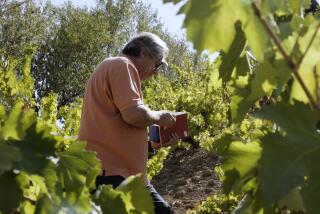A Shot of <i> Boz</i>
- Share via
ISTANBUL — For years I had heard about boz , a street vendor’s beverage sold in Tirana, Albania, when my husband was a child.
“Well, what’s it like?” I would ask him. “Perhaps we can duplicate it at home.”
What was it like? My husband, who knew food and drink better than most, was at a loss. “Well,” he said, “it’s this thick, goopy, white drink that everyone loved. The vendor would yell ‘boz , boz .’ ” This is where my husband would begin imitating the nasal call from years past.
Since Albania was then under a severely oppressive Communist regime, a place never to be visited or heard from since the end of World War II, it seemed that boz , the phantom drink, would remain a mystery forever.
Then, during a winter trip to Istanbul in 1983, as we strolled along the gardens of St. Sophia Cathedral, my husband stopped in his tracks.
“ Boz !” he shouted. “Quick, come here.”
I looked around for a Mr. Boz, who I imagined was about to experience a warm reunion with my husband.
“The drink, boz . It’s here,” he said.
I approached the vendor. Strapped to his shoulders was a long cylinder, much like an old-fashioned milk can, from which glasses of boz were poured.
My husband immediately put down 5,000 lira (about 40 cents) for a glass and offered me the first sip. I hesitated. The thick, discolored brew was hardly inviting. “Go on, try it. You don’t have to drink it all.” My lips quivered over the sea of white glue, then dipped slightly into the mass. “Here,” I said, after a taste. “You can have the whole thing.”
My husband was amazed. “You don’t like it?”
“Awful stuff. Who does?”
As it turns out, millions of Turks adore boza (the word ends with an “ a “ in Turkish) as a quick-energy pick-up to and from work, shopping or snacking. It is so popular that hundreds of boza vendors are unleashed on streets, and several shops, called Vefa Bozacisi, after the Vefa family, which holds exclusive rights to manufacture the drink, feature the beverage--and only the beverage.
How, then, did the drink get to Albania? I reasoned that the drink was spread to Albania by Ottomans, who occupied the Balkan Peninsula for 500 years until the turn of the century. According to our resident linguistic historian, Charles Perry, boza --meaning fermented grain (usually more like a porridge than a beer)--is a word found in languages of the Turkish family as far away as Xinjiang Province, China.
Sadik Vefa, however, the third-generation proprietor of the leading boza family, insists that the drink was brought to Turkey from Albania by his grandfather, who immigrated to Turkey in 1850. But foods of that period often were interchangeable, traveling back and forth so often as to obscure their origins.
You make the drink by mashing cooked wheat berries into mush, adding sugar to ferment it, then diluting it to proper consistency. Vefa’s drink is diluted slightly to produce a thick texture, while many street vendors dilute the drink to the less desirable thin-syrup consistency. “That’s not the true boza Vefa, “ said Vefa’s wife, Sitare, who accompanied us on the tour of the tiny shop and factory on Vefa Street--named after both the family and their properly thick drink. Dropping a few roasted garbanzos to float on top, a clerk poured a glass of boza for several Turks who stopped to sip the chilled brew on this scorching day.
The drink was originally manufactured to serve the Ottoman palaces, but it became so popular, Grandfather Vefa opened his first stand on the street now named after him. In 1876 the shop was expanded to its present form, a cafe with a few tables and counter in front, and the small factory in back. Except for modern materials used in constructing the boza tanks, the method of making boza remains the same. In times past, men and women were segregated as they sipped the drink. Today the shop is packed day and night by members of both sexes and all ages. Serious business starts in November at the onset of cold weather, when the drink is traditionally most enjoyed by Turks.
“It’s a healthy, fortifying winter drink,” said Vefa.
The beverage is high in calories (about 1,000) and could be considered a complete meal in a drink. It is high in vitamins B, B6, B12, A and D. It is high in lactic acid and contains some protein.
The formula for boza remains a family secret and is exclusive to the Vefa family. Because the yeast in the mixture has a tendency to expand, the drink cannot be bottled or stored for long periods of time. As a result, freshness is almost guaranteed. Vefa, however, has plans for creating a dry mix that can be reconstituted into a drink. Vefa sees the high-nutrition drink as a simple solution to hungry populations and in situations where people would benefit from an inexpensive, quick energy boost, such as students and pilots.
Boz is no longer found commercially in Albania, having been wiped out along with other past cultural indulgences during the almost five decades of Communist rule. I understand, however, that boz is prepared in some private homes in Albania. Frankly, I don’t know whether I should laugh or cry. What I do know is that if boz does make its way to America, as yogurt did (and who would have predicted that?), I shall be the first to say, “I told you so.”
More to Read
Eat your way across L.A.
Get our weekly Tasting Notes newsletter for reviews, news and more.
You may occasionally receive promotional content from the Los Angeles Times.








